2019 HYUNDAI ELANTRA SPORT fuel filter
[x] Cancel search: fuel filterPage 433 of 534
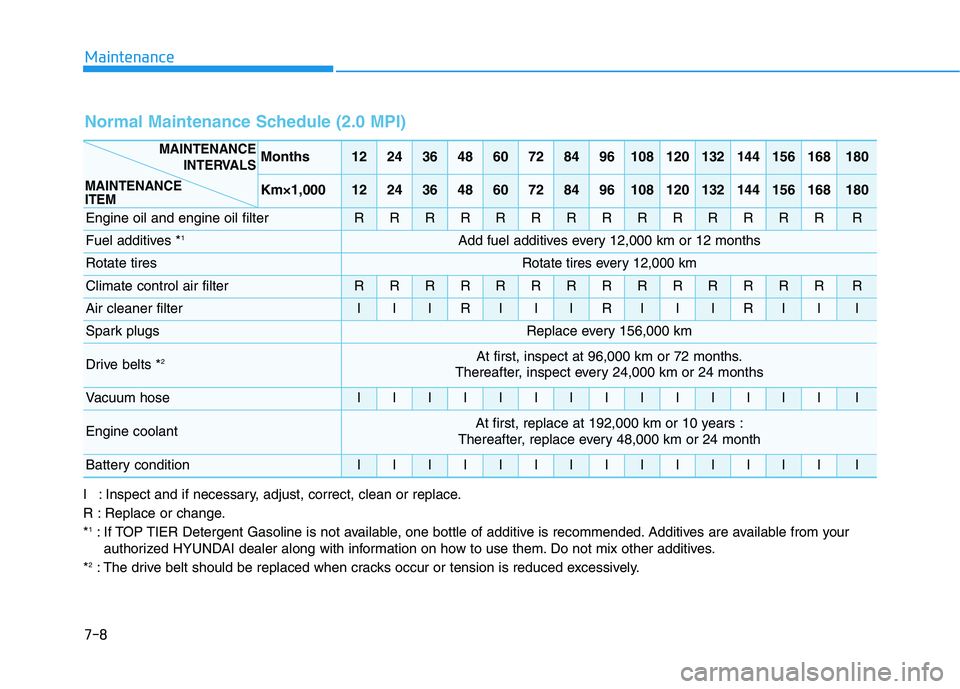
7-8
Maintenance
I : Inspect and if necessary, adjust, correct, clean or replace.
R : Replace or change.*1
: If TOP TIER Detergent Gasoline is not available, one bottle of additive is recommended. Additives are available from your
authorized HYUNDAI dealer along with information on how to use them. Do not mix other additives.
* 2
: The drive belt should be replaced when cracks occur or tension is reduced excessively.
Normal Maintenance Schedule (2.0 MPI)
Months1224364860728496108120132144156168180
Km×1,0001224364860728496108120132144156168180
Engine oil and engine oil filterRRRRRRRRRRRRRRR
Fuel additives * 1Add fuel additives every 12,000 km or 12 months
Rotate tiresRotate tires every 12,000 km
Climate control air filterRRRRRRRRRRRRRRR
Air cleaner filterIIIRIIIRIIIRIII
Spark plugsReplace every 156,000 km
Drive belts *2At first, inspect at 96,000 km or 72 months.
Thereafter, inspect every 24,000 km or 24 months
Vacuum hoseIIIIIIIIIIIIIII
Engine coolantAt first, replace at 192,000 km or 10 years :
Thereafter, replace every 48,000 km or 24 month
Battery conditionIIIIIIIIIIIIIII
MAINTENANCE
INTERVALS
MAINTENANCE ITEM
Page 435 of 534
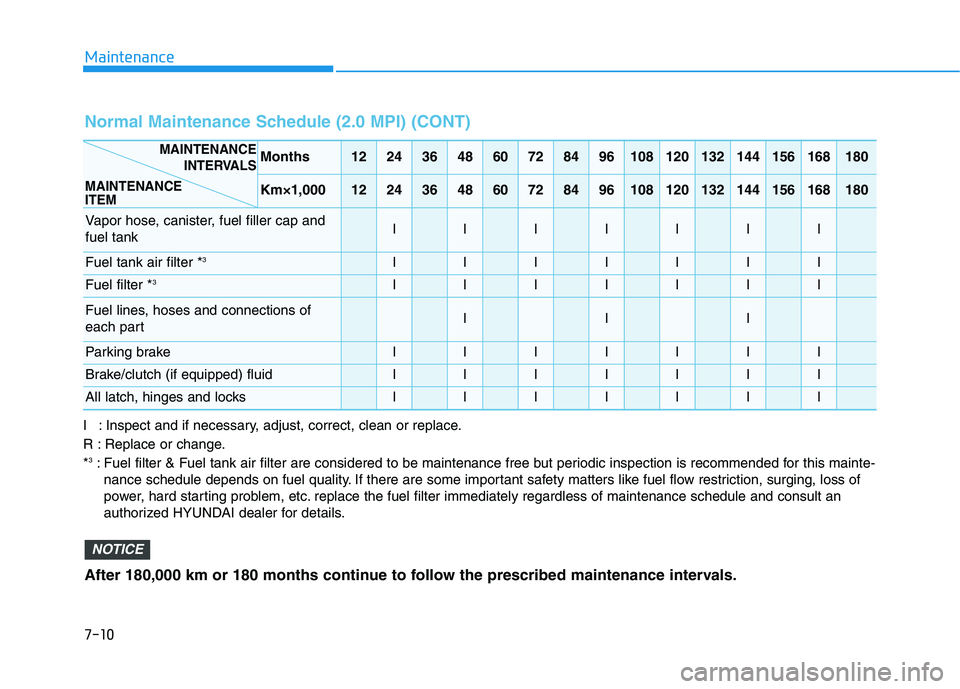
7-10
Maintenance
I : Inspect and if necessary, adjust, correct, clean or replace.
R : Replace or change.*3
: Fuel filter & Fuel tank air filter are considered to be maintenance free but periodic inspection is recommended for this maint e-
nance schedule depends on fuel quality. If there are some important safety matters like fuel flow restriction, surging, loss of
power, hard starting problem, etc. replace the fuel filter immediately regardless of maintenance schedule and consult an
authorized HYUNDAI dealer for details.
Normal Maintenance Schedule (2.0 MPI) (CONT)
Months1224364860728496108120132144156168180
Km×1,0001224364860728496108120132144156168180
Vapor hose, canister, fuel filler cap and fuel tankIIIIIII
Fuel tank air filter * 3IIIIIII
Fuel filter *3IIIIIII
Fuel lines, hoses and connections of
each partIII
Parking brakeIIIIIII
Brake/clutch (if equipped) fluidIIIIIII
All latch, hinges and locks IIIIIII
MAINTENANCE
INTERVALS
MAINTENANCE ITEM
After 180,000 km or 180 months continue to follow the prescribed maintenance intervals.
NOTICE
Page 438 of 534
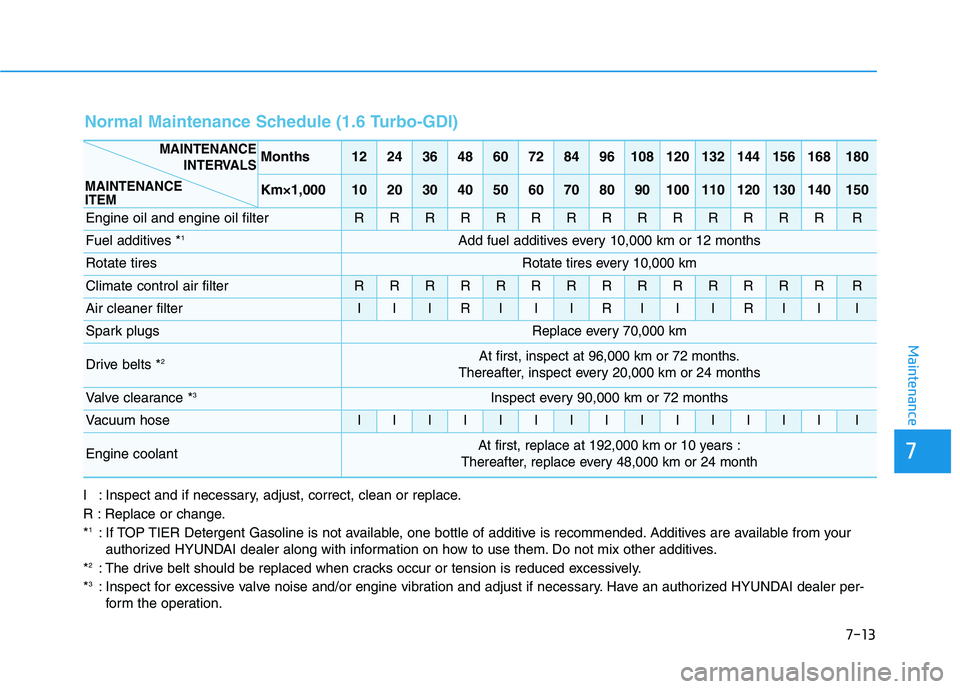
7-13
7
Maintenance
I : Inspect and if necessary, adjust, correct, clean or replace.
R : Replace or change.*1
: If TOP TIER Detergent Gasoline is not available, one bottle of additive is recommended. Additives are available from your
authorized HYUNDAI dealer along with information on how to use them. Do not mix other additives.
* 2
: The drive belt should be replaced when cracks occur or tension is reduced excessively.
* 3
: Inspect for excessive valve noise and/or engine vibration and adjust if necessary. Have an authorized HYUNDAI dealer per-
form the operation.
Normal Maintenance Schedule (1.6 Turbo-GDI)
Months1224364860728496108120132144156168180
Km×1,000102030405060708090100110120130140150
Engine oil and engine oil filterRRRRRRRRRRRRRRR
Fuel additives * 1Add fuel additives every 10,000 km or 12 months
Rotate tiresRotate tires every 10,000 km
Climate control air filterRRRRRRRRRRRRRRR
Air cleaner filterIIIRIIIRIIIRIII
Spark plugsReplace every 70,000 km
Drive belts *2At first, inspect at 96,000 km or 72 months.
Thereafter, inspect every 20,000 km or 24 months
Valve clearance * 3Inspect every 90,000 km or 72 months
Vacuum hoseIIIIIIIIIIIIIII
Engine coolantAt first, replace at 192,000 km or 10 years :
Thereafter, replace every 48,000 km or 24 month
MAINTENANCE INTERVALS
MAINTENANCE ITEM
Page 440 of 534
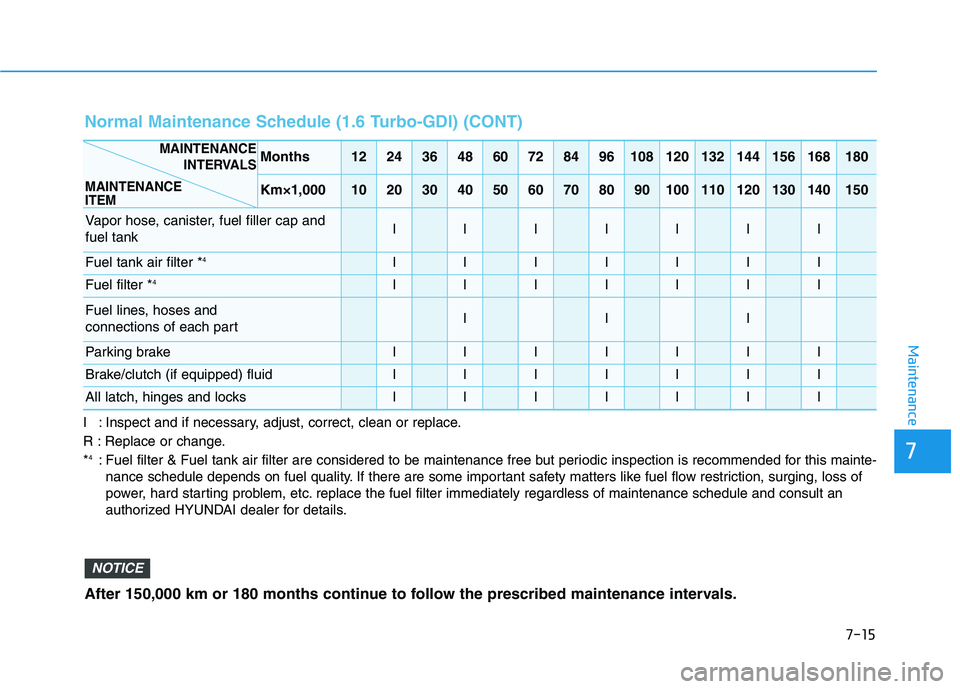
7-15
7
Maintenance
I : Inspect and if necessary, adjust, correct, clean or replace.
R : Replace or change.*4
: Fuel filter & Fuel tank air filter are considered to be maintenance free but periodic inspection is recommended for this maint e-
nance schedule depends on fuel quality. If there are some important safety matters like fuel flow restriction, surging, loss of
power, hard starting problem, etc. replace the fuel filter immediately regardless of maintenance schedule and consult an
authorized HYUNDAI dealer for details.
Normal Maintenance Schedule (1.6 Turbo-GDI) (CONT)
Months1224364860728496108120132144156168180
Km×1,000102030405060708090100110120130140150
Vapor hose, canister, fuel filler cap and fuel tankIIIIIII
Fuel tank air filter * 4IIIIIII
Fuel filter *4IIIIIII
Fuel lines, hoses and
connections of each partIII
Parking brakeIIIIIII
Brake/clutch (if equipped) fluidIIIIIII
All latch, hinges and locks IIIIIII
MAINTENANCE
INTERVALS
MAINTENANCE ITEM
After 150,000 km or 180 months continue to follow the prescribed maintenance intervals.
NOTICE
Page 443 of 534
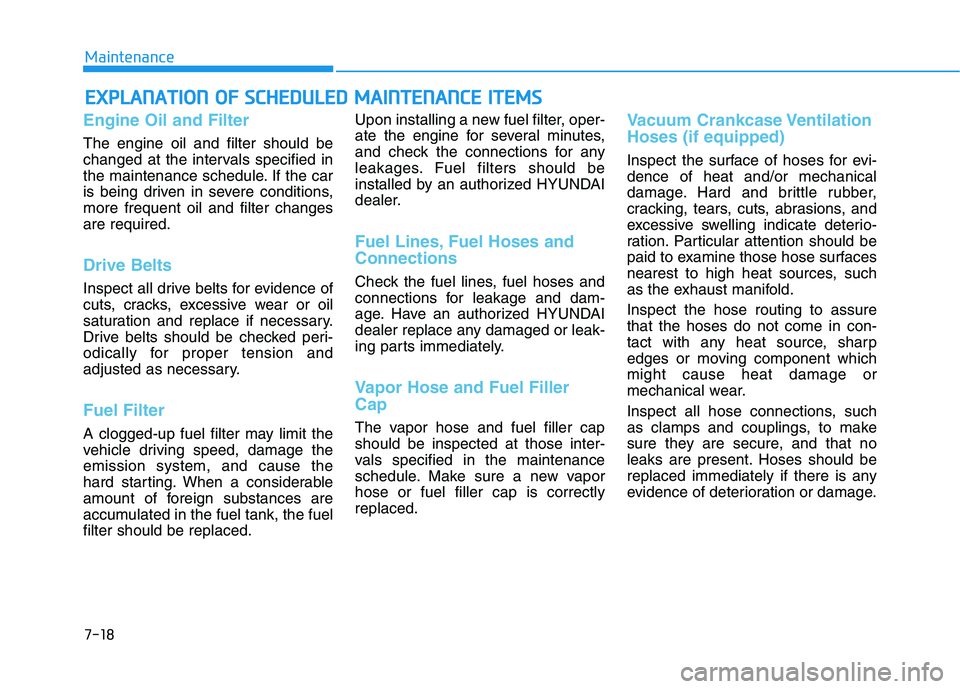
7-18
MaintenanceE
E XX PPLLAA NN AATTIIOO NN OO FF SS CC HH EEDD UU LLEE DD MM AAIINN TTEENN AANN CCEE IITT EEMM SS
Engine Oil and Filter
The engine oil and filter should be
changed at the intervals specified in
the maintenance schedule. If the car
is being driven in severe conditions,more frequent oil and filter changesare required.
Drive Belts
Inspect all drive belts for evidence of
cuts, cracks, excessive wear or oil
saturation and replace if necessary.
Drive belts should be checked peri-
odically for proper tension and
adjusted as necessary.
Fuel Filter
A clogged-up fuel filter may limit the
vehicle driving speed, damage theemission system, and cause the
hard starting. When a considerable
amount of foreign substances are
accumulated in the fuel tank, the fuelfilter should be replaced. Upon installing a new fuel filter, oper-
ate the engine for several minutes,
and check the connections for any
leakages. Fuel filters should be
installed by an authorized HYUNDAI
dealer.
Fuel Lines, Fuel Hoses and Connections
Check the fuel lines, fuel hoses and
connections for leakage and dam-
age. Have an authorized HYUNDAI
dealer replace any damaged or leak-
ing parts immediately.
Vapor Hose and Fuel Filler Cap
The vapor hose and fuel filler cap should be inspected at those inter-
vals specified in the maintenance
schedule. Make sure a new vaporhose or fuel filler cap is correctlyreplaced.
Vacuum Crankcase Ventilation Hoses (if equipped)
Inspect the surface of hoses for evi- dence of heat and/or mechanical
damage. Hard and brittle rubber,
cracking, tears, cuts, abrasions, and
excessive swelling indicate deterio-
ration. Particular attention should be
paid to examine those hose surfaces
nearest to high heat sources, such
as the exhaust manifold. Inspect the hose routing to assure that the hoses do not come in con-
tact with any heat source, sharp
edges or moving component whichmight cause heat damage or
mechanical wear.
Inspect all hose connections, such
as clamps and couplings, to make
sure they are secure, and that no
leaks are present. Hoses should be
replaced immediately if there is any
evidence of deterioration or damage.
Page 509 of 534

7-84
Maintenance
The emission control system of your
vehicle is covered by a written limited
warranty. Please see the warranty
information contained in the Service
Passport in your vehicle.
Your vehicle is equipped with an emission control system to meet all
applicable emission regulations.There are three emission control
systems, as follows.
(1) Crankcase emission control sys-tem
(2) Evaporative emission control sys- tem
(3) Exhaust emission control systemIn order to assure the proper function
of the emission control systems, it is
recommended that you have your
vehicle inspected and maintained by
an authorized HYUNDAI dealer inaccordance with the maintenance
schedule in this manual. For the Inspection and
Maintenance Test (With Electronic
Stability Control (ESC) system)
To prevent the vehicle from mis-
firing during dynamometer test-
ing, turn the Electronic Stability
Control (ESC) system off by
pressing the ESC switch (ESCOFF light illuminated).
After dynamometer testing is completed, turn the ESC system
back on by pressing the ESC
switch again.1. Crankcase Emission Control
System
The positive crankcase ventilation
system is employed to prevent air
pollution caused by blow-by gases
being emitted from the crankcase.This system supplies fresh filtered air
to the crankcase through the air
intake hose. Inside the crankcase,
the fresh air mixes with blow-by
gases, which then pass through the
PCV valve into the induction system.
2. Evaporative Emission ControlSystem Including Onboard
Refueling Vapor Recovery
(ORVR)
The Evaporative Emission Control
System is designed to prevent fuel
vapors from escaping into the atmos-
phere. The ORVR system is
designed to allow the vapors fromthe fuel tank to be loaded into a can-ister while refueling at the gas sta-
tion, preventing the escape of fuel
vapors into the atmosphere.
NOTICE
EEMM IISS SSIIOO NN CC OO NNTTRR OO LL SS YY SSTT EEMM
Page 527 of 534
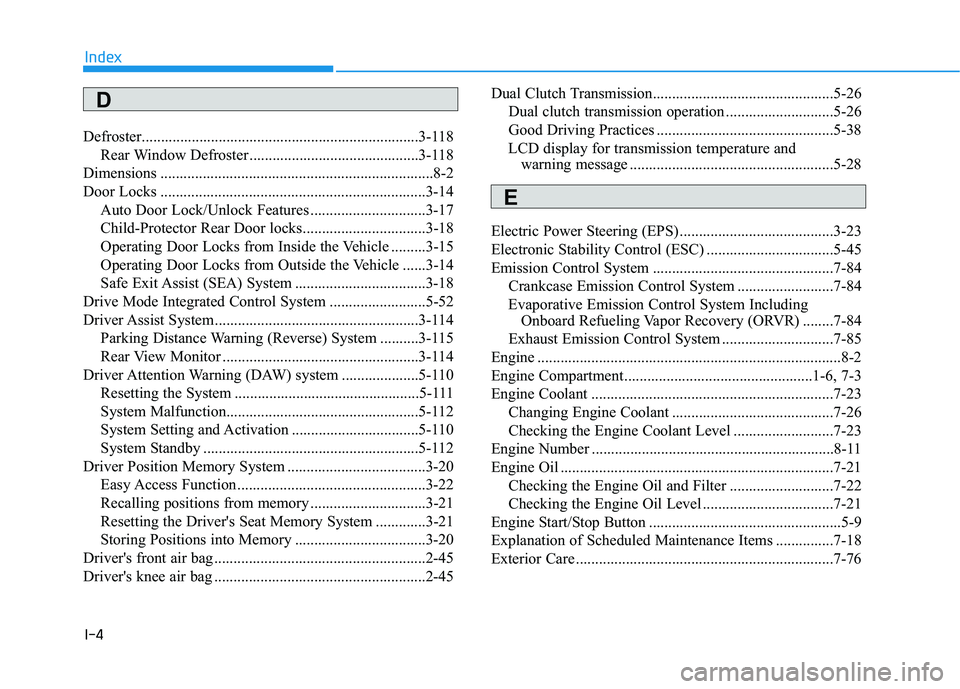
I-4
Defroster........................................................................3-118
Rear Window Defroster ............................................3-118
Dimensions .......................................................................8-2
Door Locks .....................................................................3-14 Auto Door Lock/Unlock Features ..............................3-17
Child-Protector Rear Door locks................................3-18
Operating Door Locks from Inside the Vehicle .........3-15
Operating Door Locks from Outside the Vehicle ......3-14
Safe Exit Assist (SEA) System ..................................3-18
Drive Mode Integrated Control System .........................5-52
Driver Assist System .....................................................3-114 Parking Distance Warning (Reverse) System ..........3-115
Rear View Monitor ...................................................3-114
Driver Attention Warning (DAW) system ....................5-110
Resetting the System ................................................5-111
System Malfunction..................................................5-112
System Setting and Activation .................................5-110
System Standby ........................................................5-112
Driver Position Memory System ....................................3-20 Easy Access Function .................................................3-22
Recalling positions from memory ..............................3-21
Resetting the Driver's Seat Memory System .............3-21
Storing Positions into Memory ..................................3-20
Driver's front air bag .......................................................2-45
Driver's knee air bag .......................................................2-45 Dual Clutch Transmission...............................................5-26
Dual clutch transmission operation ............................5-26
Good Driving Practices ..............................................5-38
LCD display for transmission temperature and warning message .....................................................5-28
Electric Power Steering (EPS) ........................................3-23
Electronic Stability Control (ESC) .................................5-45
Emission Control System ...............................................7-84 Crankcase Emission Control System .........................7-84
Evaporative Emission Control System Including Onboard Refueling Vapor Recovery (ORVR) ........7-84
Exhaust Emission Control System .............................7-85
Engine ...............................................................................8-2
Engine Compartment.................................................1-6, 7-3
Engine Coolant ...............................................................7-23 Changing Engine Coolant ..........................................7-26
Checking the Engine Coolant Level ..........................7-23
Engine Number ...............................................................8-11
Engine Oil .......................................................................7-21 Checking the Engine Oil and Filter ...........................7-22
Checking the Engine Oil Level ..................................7-21
Engine Start/Stop Button ..................................................5-9
Explanation of Scheduled Maintenance Items ...............7-18
Exterior Care ...................................................................7-76
Index
D
E